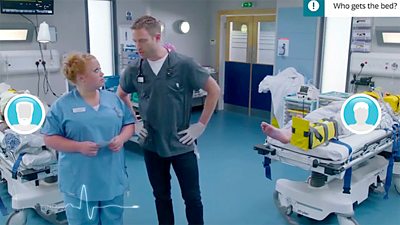From the radio dramas and to sci-fi comedy The Inspection Chamber (2017), produced exclusively for the latest voice controlled devices, the ����ý has long history of exploring the possibilities of interactive storytelling. Each of our experiments has provided valuable lessons on both the opportunities and the challenges of putting control of the story into the hands of the audience.

(Image for ����ý R&D by )
Netflix’s recent (part of Charlie Brooker’s Black Mirror series) has also explored similar challenges, whilst simultaneously sparking the discussion about ‘choose your own adventure’ style interactive narratives. With the medium currently back in focus it feels like a good time to ask where the future of interactive storytelling lies and how ����ý R&D are helping to shape it?
In order to predict where we’re heading, it’s helpful to first look back through some of our recent storytelling experiments and share some of the things we’ve learned to date.
What have we learned so far?
There’s so much we could say in response to this question. It all depends if you want to know about writing, story-mapping, user experience considerations, production challenges or technology platforms.
We can however share some key takeaways that, in our experience, can be applied across most interactive narratives:
- Don’t let interactivity get in the way of a good story! This is perhaps the most common mistake producers make. Decision points should never be there for the sake of it. They should always serve a purpose, with the most powerful of these being to deepen engagement through meaningful consequences.
- Story branches don’t need to multiply. Creating a million paths with a thousand different possible endings risks diluting the integrity of your core story. It also requires production of an unfeasibly expensive amount of content and will probably drive you mad in the process!
- Consider your platform. Licensing existing software to author and publish interactive video saves the time and money compared with building a bespoke platform from scratch, but you will have to work within its capabilities. Do your homework by analysing the costs and benefits before committing to your tech solution.
- Understand the context of your user. As with all interactive experiences, UX is essential to the successful design of interactive drama. Whether it plays out as video, audio, text or still images, particular consideration needs to be given to pacing of interactions and to signposting when to ‘lean forward’ and interact.
Obviously, these points only skim the surface of what we’ve learned so far. To understand how we’ve come to these conclusions, it’s helpful to take a closer look at some of the interactive dramas we’ve helped to create and test with audiences through ����ý Taster in recent years.
Our World War (2014)

Set in the Battle of the Somme in 1916, Our World War tells the story of Arthur Foulkes, a young soldier forced to take command of a small section of men after his commending officer is killed. The viewer must make choices for Arthur, effecting how the story plays out and ultimately deciding the fate of the all the men.
This collaboration between ����ý Knowledge and Learning, ����ý Three and Salford-based games and animation studio MI, attempted to bring the realities of the First World War to a young audience 100 years after the events.
We asked ourselves ‘would active participation in the story make viewers care more about the outcome?’ In short, the answer is yes. Audience feedback consistently showed a greater emotional impact of events when the viewer felt it to be a direct consequence of their decisions.
Through the process of making Our World War, we also learned much more, including (but by no means restricted to) structuring narrative branches to ensure a sense of control without diluting the core the story, the importance of consistent pacing of the ‘lean forward’ moments and best practices across UX and interface design.
Many of these lessons where subsequently rolled into 2015’s ‘’ programme in which brought digital agencies together with ����ý production teams to pilot new content formats.
Casualty First Day (2015)

One such pilot was, , an interactive episode of ����ý One’s long-running hospital drama produced in collaboration with digital production studio .
Shot entirely in first person, First Day saw viewers assume the role of a junior doctor navigating their way through their first day at Holby General. Through a combination of difficult choices and mini games, the viewer (or user) discovers if they have what it takes to make it in this high-pressured environment.
Along with learning more about the challenges of cross-platform production, narrative mapping and user experience, we were also looking to test the durability of a third-party interactive video platform called . The pilot allowed us to understand how far we could push the tech and where we would need to de-scope or build bespoke functionality in future.
How To Survive a Nuclear Bomb? (2016)

Another Future of Content pilot, , saw ����ý History and Brighton based-digital agency set young audiences the ominous challenge of surviving the aftermath of a nuclear blast!
Much like Our World War, the pilot tells a fictional story based on historical case studies, playing out as interactive narrative with game mechanics. The right choices see the user survive the vital first few days, while the wrong choices mean they are not so fortunate! As a game, they can always start again and have another try, making for great repeatability, as discussed by Oliver Spall in a previous blog post.
Also like Our World War, the consequences of the choices are played back to the user as a score. This is accompanied by factual information taken from historical documentation from the Cold War.
Where it differs from Our World War is that the story is set in contemporary Britain and is told, not through video, but primarily as a stylish parallax-scrolling graphic novel. This proved much more cost effective than a full-scale drama production and a great repeatable format for young audiences.
Where next for interactive narratives?
So where do we go from here, and how are we at ����ý R&D helping to shape that? I’ll attempt to answer these questions in the second part of this short series of posts.
- -
- ����ý R&D - Storytelling of the Future
- ����ý R&D - StoryFormer: Building the Next Generation of Storytelling
- ����ý Taster - Try Click's 1000th Interactive Episode
- ����ý News - Click 1,000: How the pick-your-own-path episode was made
- ����ý R&D - Creating a Personalised and Interactive Episode of ����ý Click with StoryKit
- ����ý R&D - Interactive Storytelling: Audience analysis from ����ý Taster
- ����ý R&D - The Unfortunates: Interacting with an Audio Story for Smart Speakers
- ����ý R&D - Responsive Radio
- ����ý R&D - Story Explorer
-

Future Experience Technologies section
This project is part of the Future Experience Technologies section
